ADACC Chapter 11: Analyzing Economic Principles and Financial Crisis
VerifiedAdded on 2023/01/13
|26
|5885
|88
Homework Assignment
AI Summary
This assignment solution for ADACC Chapter 11 delves into fundamental economic concepts, analyzing scarcity and opportunity cost with real-world examples. It examines command and free market economies, outlining their advantages and disadvantages. The solution further explores the causes and impact of the Global Financial Crisis (GFC), specifically focusing on the liquidity crisis and Australia's response, including government actions and the role of the Reserve Bank of Australia. Finally, it discusses Australian banks' capital adequacy ratios in relation to Basel Accords and APRA guidelines, alongside an explanation of exchange rate determination and volatility. Desklib provides access to this and many other solved assignments for students.
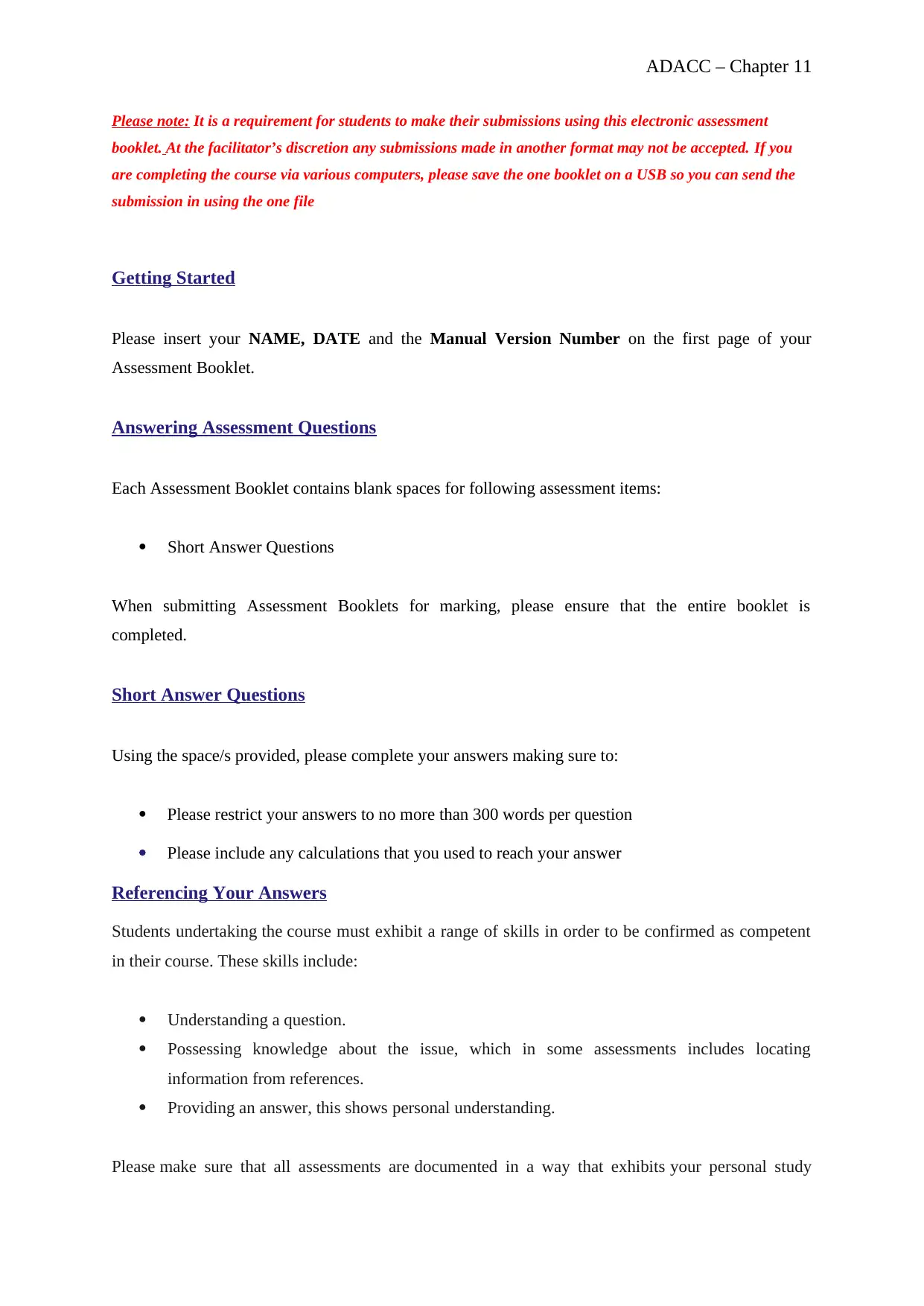
ADACC – Chapter 11
Please note: It is a requirement for students to make their submissions using this electronic assessment
booklet. At the facilitator’s discretion any submissions made in another format may not be accepted. If you
are completing the course via various computers, please save the one booklet on a USB so you can send the
submission in using the one file
Getting Started
Please insert your NAME, DATE and the Manual Version Number on the first page of your
Assessment Booklet.
Answering Assessment Questions
Each Assessment Booklet contains blank spaces for following assessment items:
Short Answer Questions
When submitting Assessment Booklets for marking, please ensure that the entire booklet is
completed.
Short Answer Questions
Using the space/s provided, please complete your answers making sure to:
Please restrict your answers to no more than 300 words per question
Please include any calculations that you used to reach your answer
Referencing Your Answers
Students undertaking the course must exhibit a range of skills in order to be confirmed as competent
in their course. These skills include:
Understanding a question.
Possessing knowledge about the issue, which in some assessments includes locating
information from references.
Providing an answer, this shows personal understanding.
Please make sure that all assessments are documented in a way that exhibits your personal study
Please note: It is a requirement for students to make their submissions using this electronic assessment
booklet. At the facilitator’s discretion any submissions made in another format may not be accepted. If you
are completing the course via various computers, please save the one booklet on a USB so you can send the
submission in using the one file
Getting Started
Please insert your NAME, DATE and the Manual Version Number on the first page of your
Assessment Booklet.
Answering Assessment Questions
Each Assessment Booklet contains blank spaces for following assessment items:
Short Answer Questions
When submitting Assessment Booklets for marking, please ensure that the entire booklet is
completed.
Short Answer Questions
Using the space/s provided, please complete your answers making sure to:
Please restrict your answers to no more than 300 words per question
Please include any calculations that you used to reach your answer
Referencing Your Answers
Students undertaking the course must exhibit a range of skills in order to be confirmed as competent
in their course. These skills include:
Understanding a question.
Possessing knowledge about the issue, which in some assessments includes locating
information from references.
Providing an answer, this shows personal understanding.
Please make sure that all assessments are documented in a way that exhibits your personal study
Paraphrase This Document
Need a fresh take? Get an instant paraphrase of this document with our AI Paraphraser
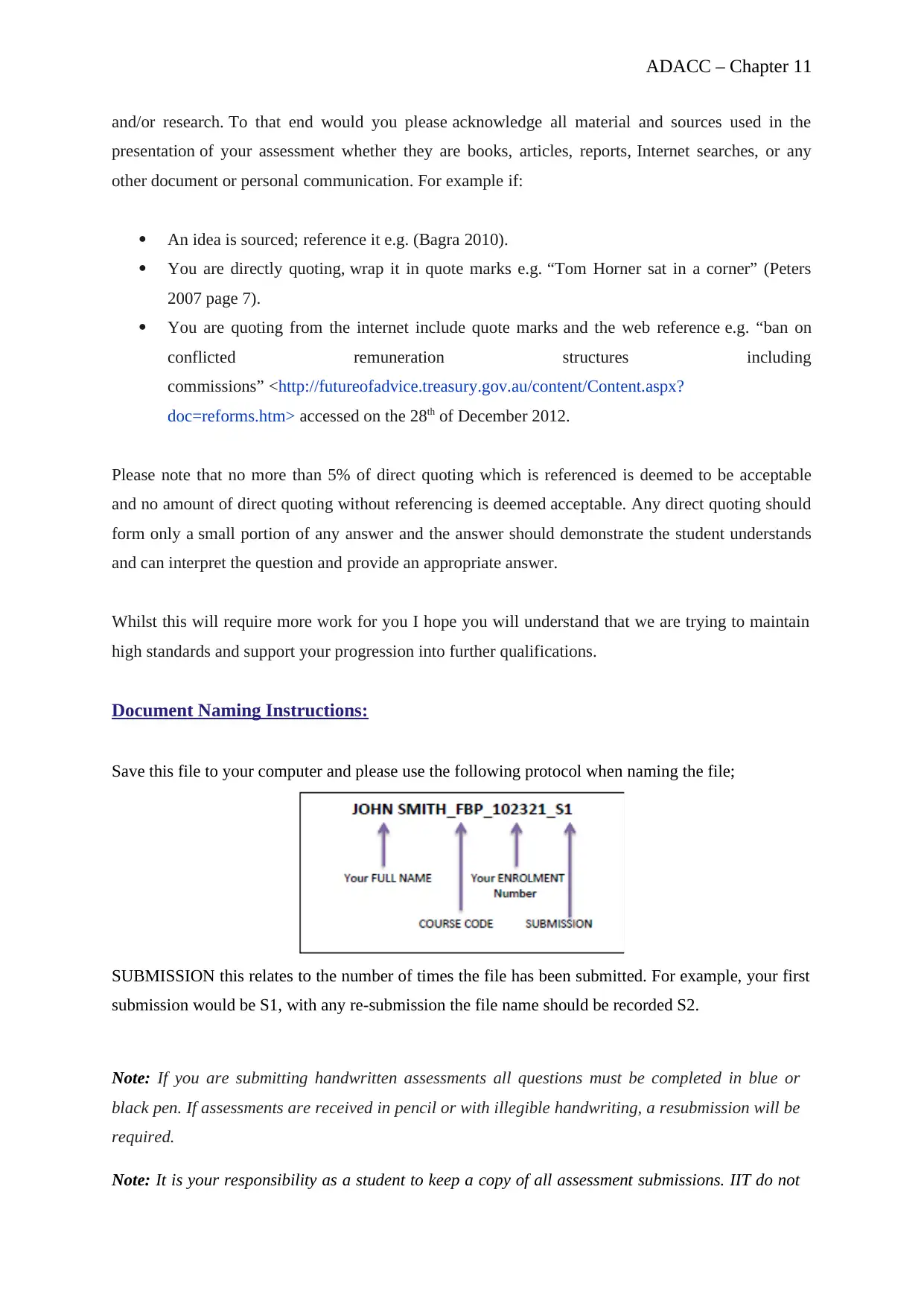
ADACC – Chapter 11
and/or research. To that end would you please acknowledge all material and sources used in the
presentation of your assessment whether they are books, articles, reports, Internet searches, or any
other document or personal communication. For example if:
An idea is sourced; reference it e.g. (Bagra 2010).
You are directly quoting, wrap it in quote marks e.g. “Tom Horner sat in a corner” (Peters
2007 page 7).
You are quoting from the internet include quote marks and the web reference e.g. “ban on
conflicted remuneration structures including
commissions” <http://futureofadvice.treasury.gov.au/content/Content.aspx?
doc=reforms.htm> accessed on the 28th of December 2012.
Please note that no more than 5% of direct quoting which is referenced is deemed to be acceptable
and no amount of direct quoting without referencing is deemed acceptable. Any direct quoting should
form only a small portion of any answer and the answer should demonstrate the student understands
and can interpret the question and provide an appropriate answer.
Whilst this will require more work for you I hope you will understand that we are trying to maintain
high standards and support your progression into further qualifications.
Document Naming Instructions:
Save this file to your computer and please use the following protocol when naming the file;
SUBMISSION this relates to the number of times the file has been submitted. For example, your first
submission would be S1, with any re-submission the file name should be recorded S2.
Note: If you are submitting handwritten assessments all questions must be completed in blue or
black pen. If assessments are received in pencil or with illegible handwriting, a resubmission will be
required.
Note: It is your responsibility as a student to keep a copy of all assessment submissions. IIT do not
and/or research. To that end would you please acknowledge all material and sources used in the
presentation of your assessment whether they are books, articles, reports, Internet searches, or any
other document or personal communication. For example if:
An idea is sourced; reference it e.g. (Bagra 2010).
You are directly quoting, wrap it in quote marks e.g. “Tom Horner sat in a corner” (Peters
2007 page 7).
You are quoting from the internet include quote marks and the web reference e.g. “ban on
conflicted remuneration structures including
commissions” <http://futureofadvice.treasury.gov.au/content/Content.aspx?
doc=reforms.htm> accessed on the 28th of December 2012.
Please note that no more than 5% of direct quoting which is referenced is deemed to be acceptable
and no amount of direct quoting without referencing is deemed acceptable. Any direct quoting should
form only a small portion of any answer and the answer should demonstrate the student understands
and can interpret the question and provide an appropriate answer.
Whilst this will require more work for you I hope you will understand that we are trying to maintain
high standards and support your progression into further qualifications.
Document Naming Instructions:
Save this file to your computer and please use the following protocol when naming the file;
SUBMISSION this relates to the number of times the file has been submitted. For example, your first
submission would be S1, with any re-submission the file name should be recorded S2.
Note: If you are submitting handwritten assessments all questions must be completed in blue or
black pen. If assessments are received in pencil or with illegible handwriting, a resubmission will be
required.
Note: It is your responsibility as a student to keep a copy of all assessment submissions. IIT do not
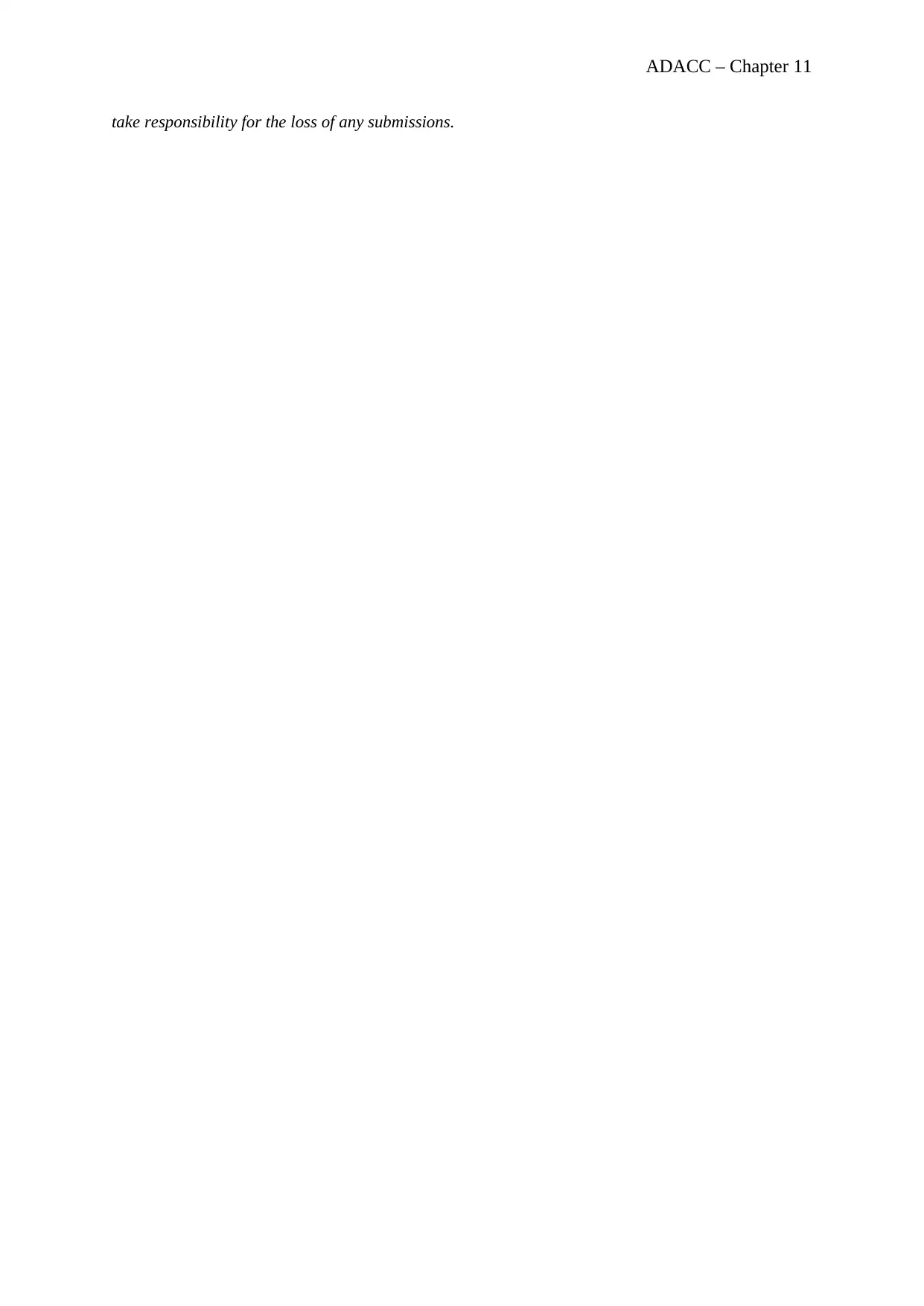
ADACC – Chapter 11
take responsibility for the loss of any submissions.
Distance Education Students
take responsibility for the loss of any submissions.
Distance Education Students
⊘ This is a preview!⊘
Do you want full access?
Subscribe today to unlock all pages.

Trusted by 1+ million students worldwide
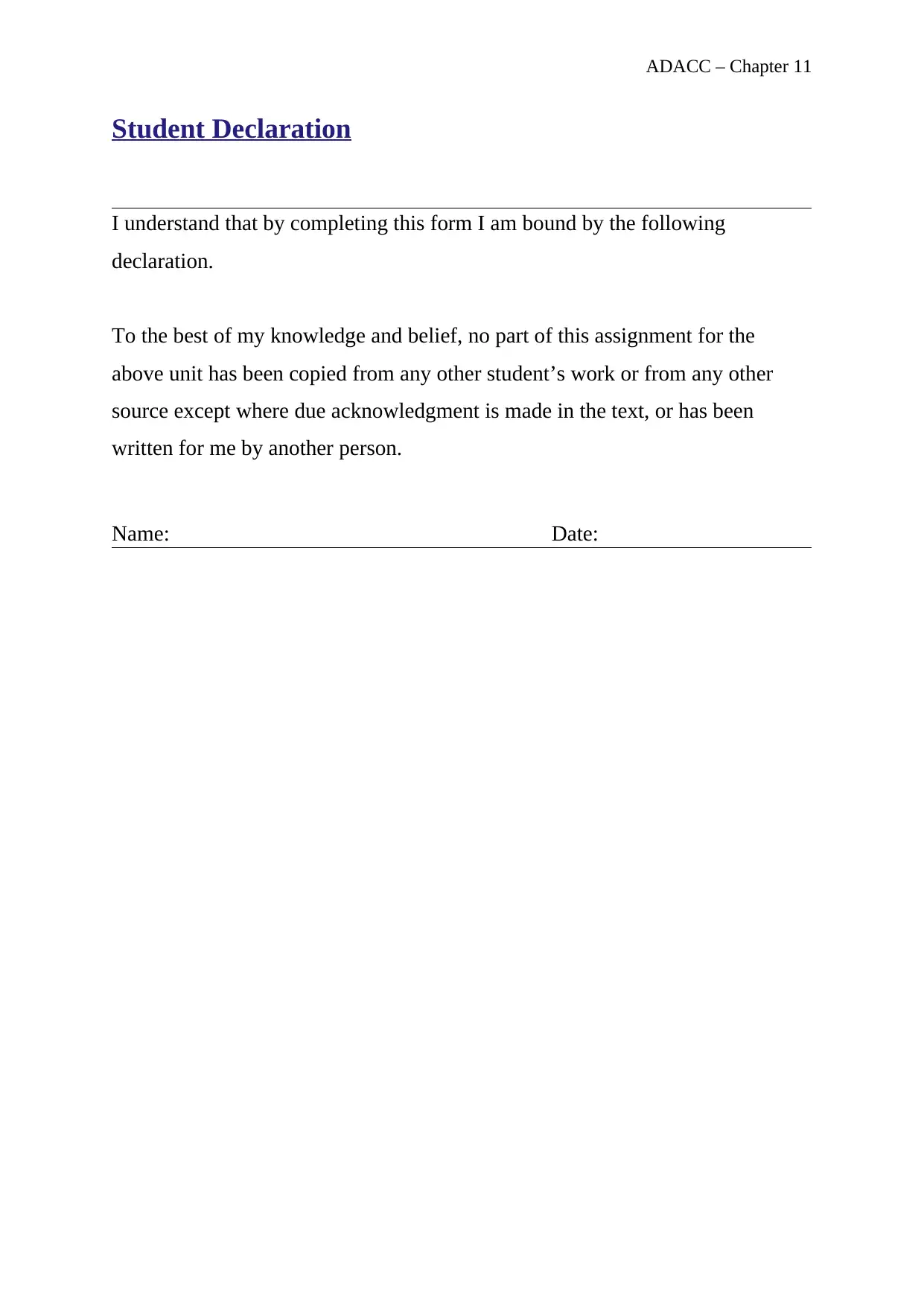
ADACC – Chapter 11
Student Declaration
I understand that by completing this form I am bound by the following
declaration.
To the best of my knowledge and belief, no part of this assignment for the
above unit has been copied from any other student’s work or from any other
source except where due acknowledgment is made in the text, or has been
written for me by another person.
Name: Date:
Student Declaration
I understand that by completing this form I am bound by the following
declaration.
To the best of my knowledge and belief, no part of this assignment for the
above unit has been copied from any other student’s work or from any other
source except where due acknowledgment is made in the text, or has been
written for me by another person.
Name: Date:
Paraphrase This Document
Need a fresh take? Get an instant paraphrase of this document with our AI Paraphraser
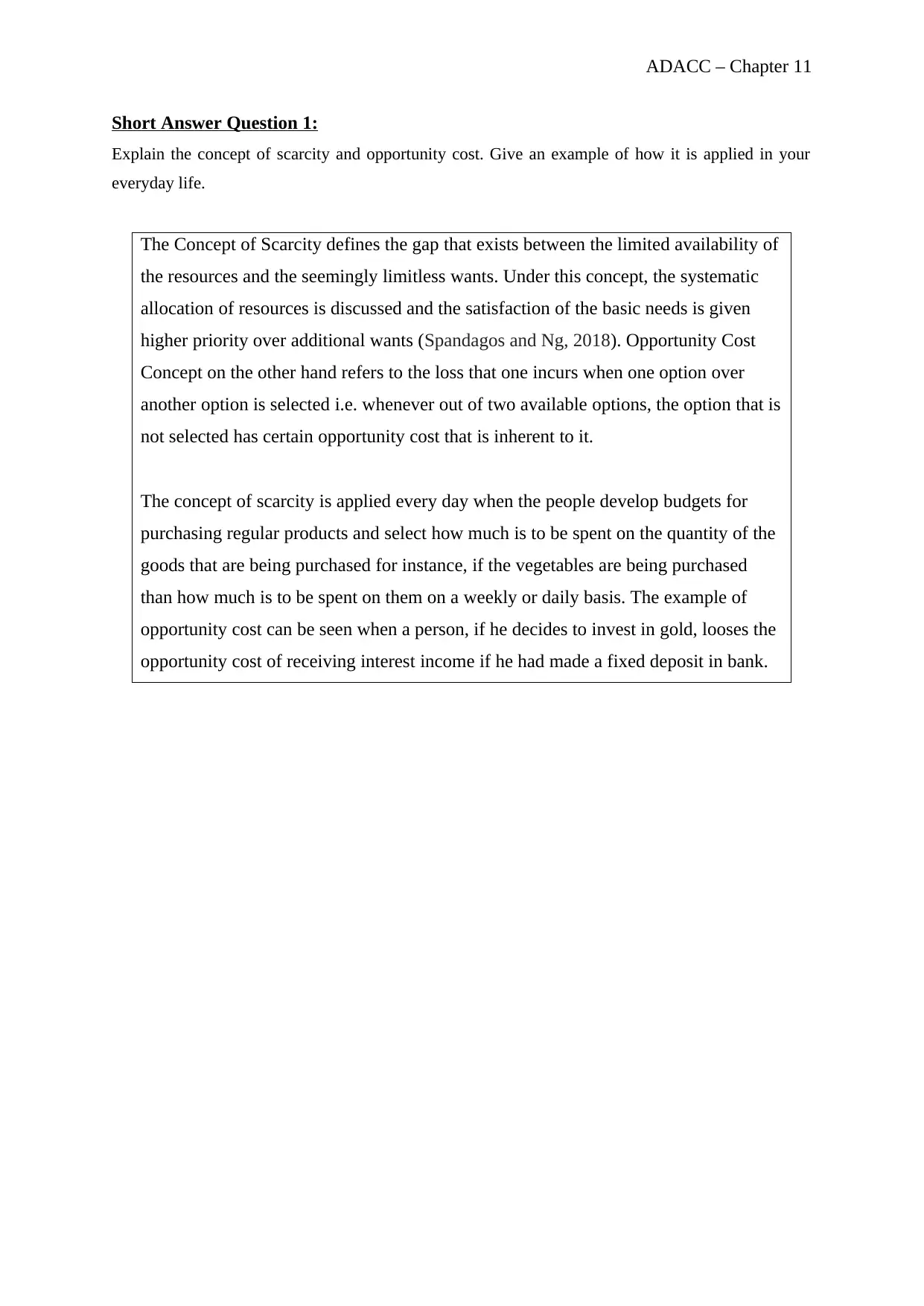
ADACC – Chapter 11
Short Answer Question 1:
Explain the concept of scarcity and opportunity cost. Give an example of how it is applied in your
everyday life.
The Concept of Scarcity defines the gap that exists between the limited availability of
the resources and the seemingly limitless wants. Under this concept, the systematic
allocation of resources is discussed and the satisfaction of the basic needs is given
higher priority over additional wants (Spandagos and Ng, 2018). Opportunity Cost
Concept on the other hand refers to the loss that one incurs when one option over
another option is selected i.e. whenever out of two available options, the option that is
not selected has certain opportunity cost that is inherent to it.
The concept of scarcity is applied every day when the people develop budgets for
purchasing regular products and select how much is to be spent on the quantity of the
goods that are being purchased for instance, if the vegetables are being purchased
than how much is to be spent on them on a weekly or daily basis. The example of
opportunity cost can be seen when a person, if he decides to invest in gold, looses the
opportunity cost of receiving interest income if he had made a fixed deposit in bank.
Short Answer Question 1:
Explain the concept of scarcity and opportunity cost. Give an example of how it is applied in your
everyday life.
The Concept of Scarcity defines the gap that exists between the limited availability of
the resources and the seemingly limitless wants. Under this concept, the systematic
allocation of resources is discussed and the satisfaction of the basic needs is given
higher priority over additional wants (Spandagos and Ng, 2018). Opportunity Cost
Concept on the other hand refers to the loss that one incurs when one option over
another option is selected i.e. whenever out of two available options, the option that is
not selected has certain opportunity cost that is inherent to it.
The concept of scarcity is applied every day when the people develop budgets for
purchasing regular products and select how much is to be spent on the quantity of the
goods that are being purchased for instance, if the vegetables are being purchased
than how much is to be spent on them on a weekly or daily basis. The example of
opportunity cost can be seen when a person, if he decides to invest in gold, looses the
opportunity cost of receiving interest income if he had made a fixed deposit in bank.
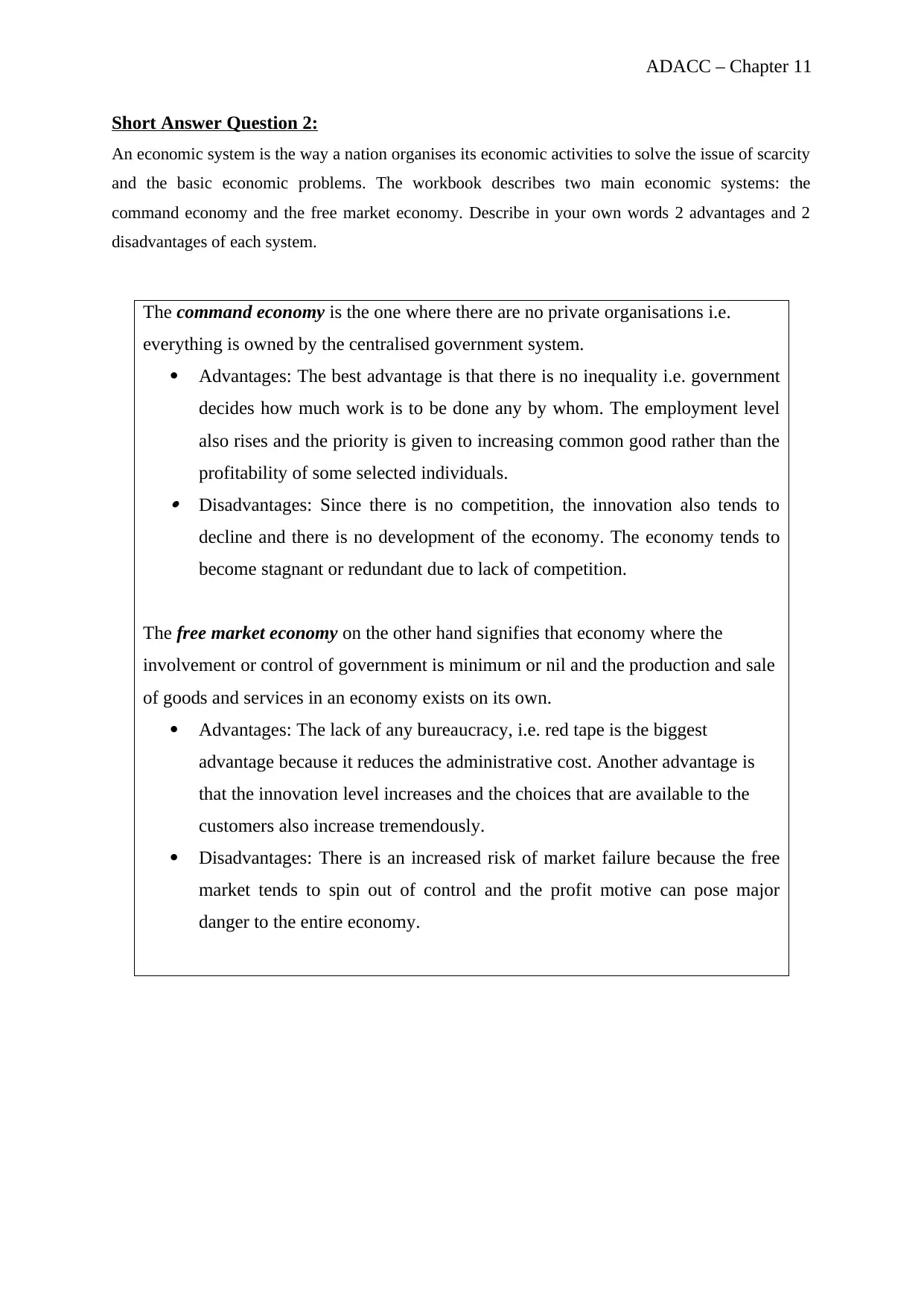
ADACC – Chapter 11
Short Answer Question 2:
An economic system is the way a nation organises its economic activities to solve the issue of scarcity
and the basic economic problems. The workbook describes two main economic systems: the
command economy and the free market economy. Describe in your own words 2 advantages and 2
disadvantages of each system.
The command economy is the one where there are no private organisations i.e.
everything is owned by the centralised government system.
Advantages: The best advantage is that there is no inequality i.e. government
decides how much work is to be done any by whom. The employment level
also rises and the priority is given to increasing common good rather than the
profitability of some selected individuals.
Disadvantages: Since there is no competition, the innovation also tends to
decline and there is no development of the economy. The economy tends to
become stagnant or redundant due to lack of competition.
The free market economy on the other hand signifies that economy where the
involvement or control of government is minimum or nil and the production and sale
of goods and services in an economy exists on its own.
Advantages: The lack of any bureaucracy, i.e. red tape is the biggest
advantage because it reduces the administrative cost. Another advantage is
that the innovation level increases and the choices that are available to the
customers also increase tremendously.
Disadvantages: There is an increased risk of market failure because the free
market tends to spin out of control and the profit motive can pose major
danger to the entire economy.
Short Answer Question 2:
An economic system is the way a nation organises its economic activities to solve the issue of scarcity
and the basic economic problems. The workbook describes two main economic systems: the
command economy and the free market economy. Describe in your own words 2 advantages and 2
disadvantages of each system.
The command economy is the one where there are no private organisations i.e.
everything is owned by the centralised government system.
Advantages: The best advantage is that there is no inequality i.e. government
decides how much work is to be done any by whom. The employment level
also rises and the priority is given to increasing common good rather than the
profitability of some selected individuals.
Disadvantages: Since there is no competition, the innovation also tends to
decline and there is no development of the economy. The economy tends to
become stagnant or redundant due to lack of competition.
The free market economy on the other hand signifies that economy where the
involvement or control of government is minimum or nil and the production and sale
of goods and services in an economy exists on its own.
Advantages: The lack of any bureaucracy, i.e. red tape is the biggest
advantage because it reduces the administrative cost. Another advantage is
that the innovation level increases and the choices that are available to the
customers also increase tremendously.
Disadvantages: There is an increased risk of market failure because the free
market tends to spin out of control and the profit motive can pose major
danger to the entire economy.
⊘ This is a preview!⊘
Do you want full access?
Subscribe today to unlock all pages.

Trusted by 1+ million students worldwide
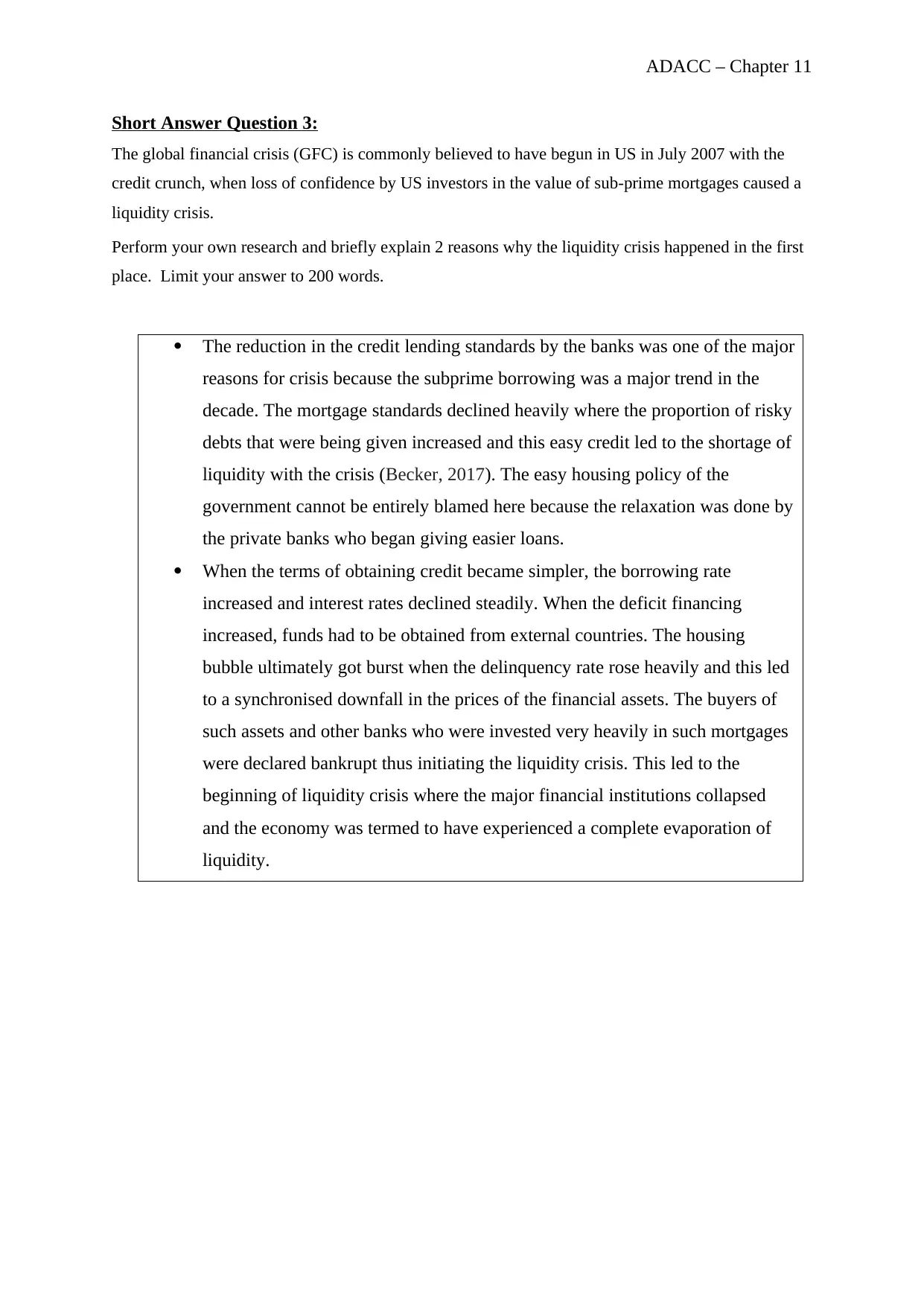
ADACC – Chapter 11
Short Answer Question 3:
The global financial crisis (GFC) is commonly believed to have begun in US in July 2007 with the
credit crunch, when loss of confidence by US investors in the value of sub-prime mortgages caused a
liquidity crisis.
Perform your own research and briefly explain 2 reasons why the liquidity crisis happened in the first
place. Limit your answer to 200 words.
The reduction in the credit lending standards by the banks was one of the major
reasons for crisis because the subprime borrowing was a major trend in the
decade. The mortgage standards declined heavily where the proportion of risky
debts that were being given increased and this easy credit led to the shortage of
liquidity with the crisis (Becker, 2017). The easy housing policy of the
government cannot be entirely blamed here because the relaxation was done by
the private banks who began giving easier loans.
When the terms of obtaining credit became simpler, the borrowing rate
increased and interest rates declined steadily. When the deficit financing
increased, funds had to be obtained from external countries. The housing
bubble ultimately got burst when the delinquency rate rose heavily and this led
to a synchronised downfall in the prices of the financial assets. The buyers of
such assets and other banks who were invested very heavily in such mortgages
were declared bankrupt thus initiating the liquidity crisis. This led to the
beginning of liquidity crisis where the major financial institutions collapsed
and the economy was termed to have experienced a complete evaporation of
liquidity.
Short Answer Question 3:
The global financial crisis (GFC) is commonly believed to have begun in US in July 2007 with the
credit crunch, when loss of confidence by US investors in the value of sub-prime mortgages caused a
liquidity crisis.
Perform your own research and briefly explain 2 reasons why the liquidity crisis happened in the first
place. Limit your answer to 200 words.
The reduction in the credit lending standards by the banks was one of the major
reasons for crisis because the subprime borrowing was a major trend in the
decade. The mortgage standards declined heavily where the proportion of risky
debts that were being given increased and this easy credit led to the shortage of
liquidity with the crisis (Becker, 2017). The easy housing policy of the
government cannot be entirely blamed here because the relaxation was done by
the private banks who began giving easier loans.
When the terms of obtaining credit became simpler, the borrowing rate
increased and interest rates declined steadily. When the deficit financing
increased, funds had to be obtained from external countries. The housing
bubble ultimately got burst when the delinquency rate rose heavily and this led
to a synchronised downfall in the prices of the financial assets. The buyers of
such assets and other banks who were invested very heavily in such mortgages
were declared bankrupt thus initiating the liquidity crisis. This led to the
beginning of liquidity crisis where the major financial institutions collapsed
and the economy was termed to have experienced a complete evaporation of
liquidity.
Paraphrase This Document
Need a fresh take? Get an instant paraphrase of this document with our AI Paraphraser
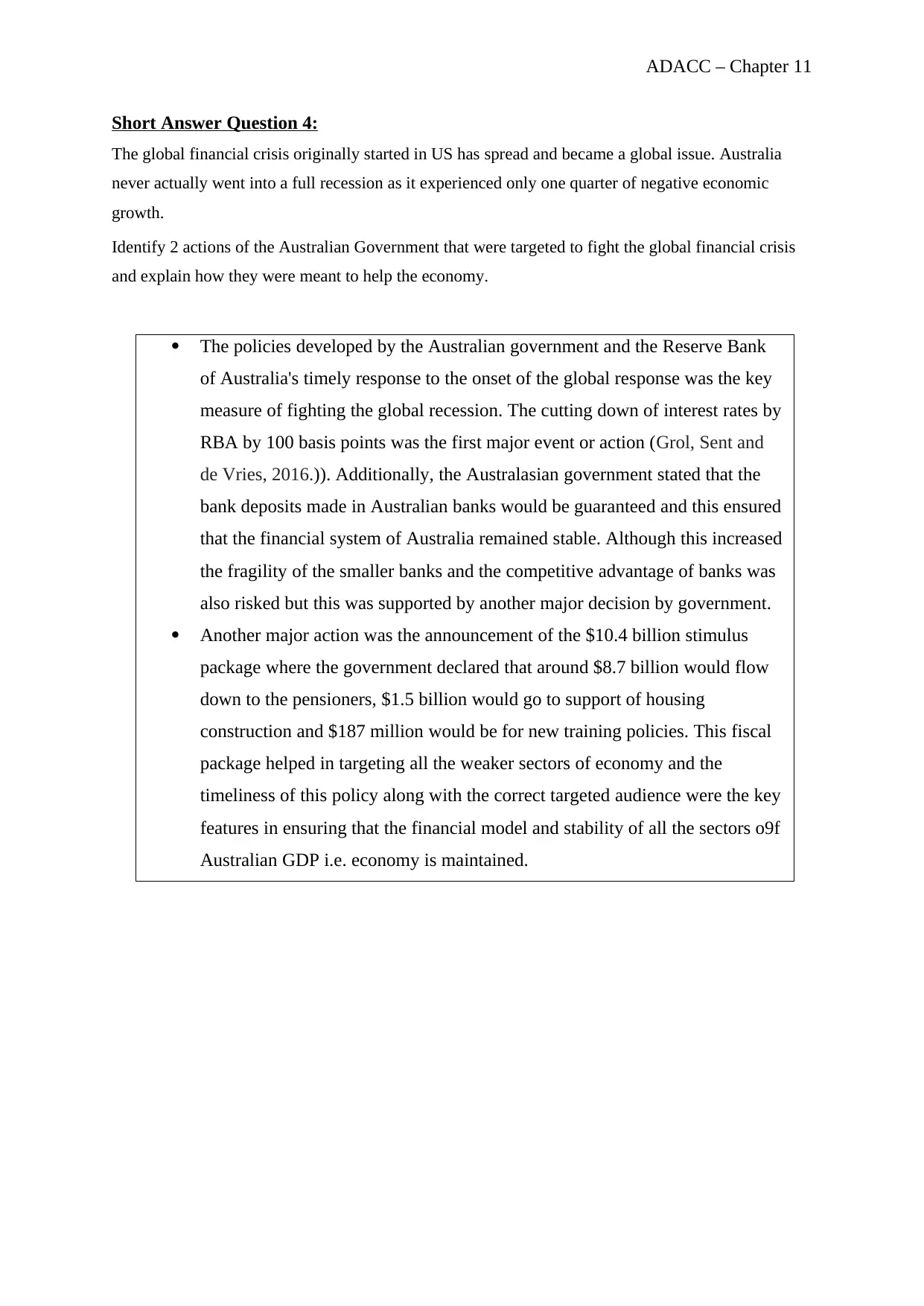
ADACC – Chapter 11
Short Answer Question 4:
The global financial crisis originally started in US has spread and became a global issue. Australia
never actually went into a full recession as it experienced only one quarter of negative economic
growth.
Identify 2 actions of the Australian Government that were targeted to fight the global financial crisis
and explain how they were meant to help the economy.
The policies developed by the Australian government and the Reserve Bank
of Australia's timely response to the onset of the global response was the key
measure of fighting the global recession. The cutting down of interest rates by
RBA by 100 basis points was the first major event or action (Grol, Sent and
de Vries, 2016.)). Additionally, the Australasian government stated that the
bank deposits made in Australian banks would be guaranteed and this ensured
that the financial system of Australia remained stable. Although this increased
the fragility of the smaller banks and the competitive advantage of banks was
also risked but this was supported by another major decision by government.
Another major action was the announcement of the $10.4 billion stimulus
package where the government declared that around $8.7 billion would flow
down to the pensioners, $1.5 billion would go to support of housing
construction and $187 million would be for new training policies. This fiscal
package helped in targeting all the weaker sectors of economy and the
timeliness of this policy along with the correct targeted audience were the key
features in ensuring that the financial model and stability of all the sectors o9f
Australian GDP i.e. economy is maintained.
Short Answer Question 4:
The global financial crisis originally started in US has spread and became a global issue. Australia
never actually went into a full recession as it experienced only one quarter of negative economic
growth.
Identify 2 actions of the Australian Government that were targeted to fight the global financial crisis
and explain how they were meant to help the economy.
The policies developed by the Australian government and the Reserve Bank
of Australia's timely response to the onset of the global response was the key
measure of fighting the global recession. The cutting down of interest rates by
RBA by 100 basis points was the first major event or action (Grol, Sent and
de Vries, 2016.)). Additionally, the Australasian government stated that the
bank deposits made in Australian banks would be guaranteed and this ensured
that the financial system of Australia remained stable. Although this increased
the fragility of the smaller banks and the competitive advantage of banks was
also risked but this was supported by another major decision by government.
Another major action was the announcement of the $10.4 billion stimulus
package where the government declared that around $8.7 billion would flow
down to the pensioners, $1.5 billion would go to support of housing
construction and $187 million would be for new training policies. This fiscal
package helped in targeting all the weaker sectors of economy and the
timeliness of this policy along with the correct targeted audience were the key
features in ensuring that the financial model and stability of all the sectors o9f
Australian GDP i.e. economy is maintained.
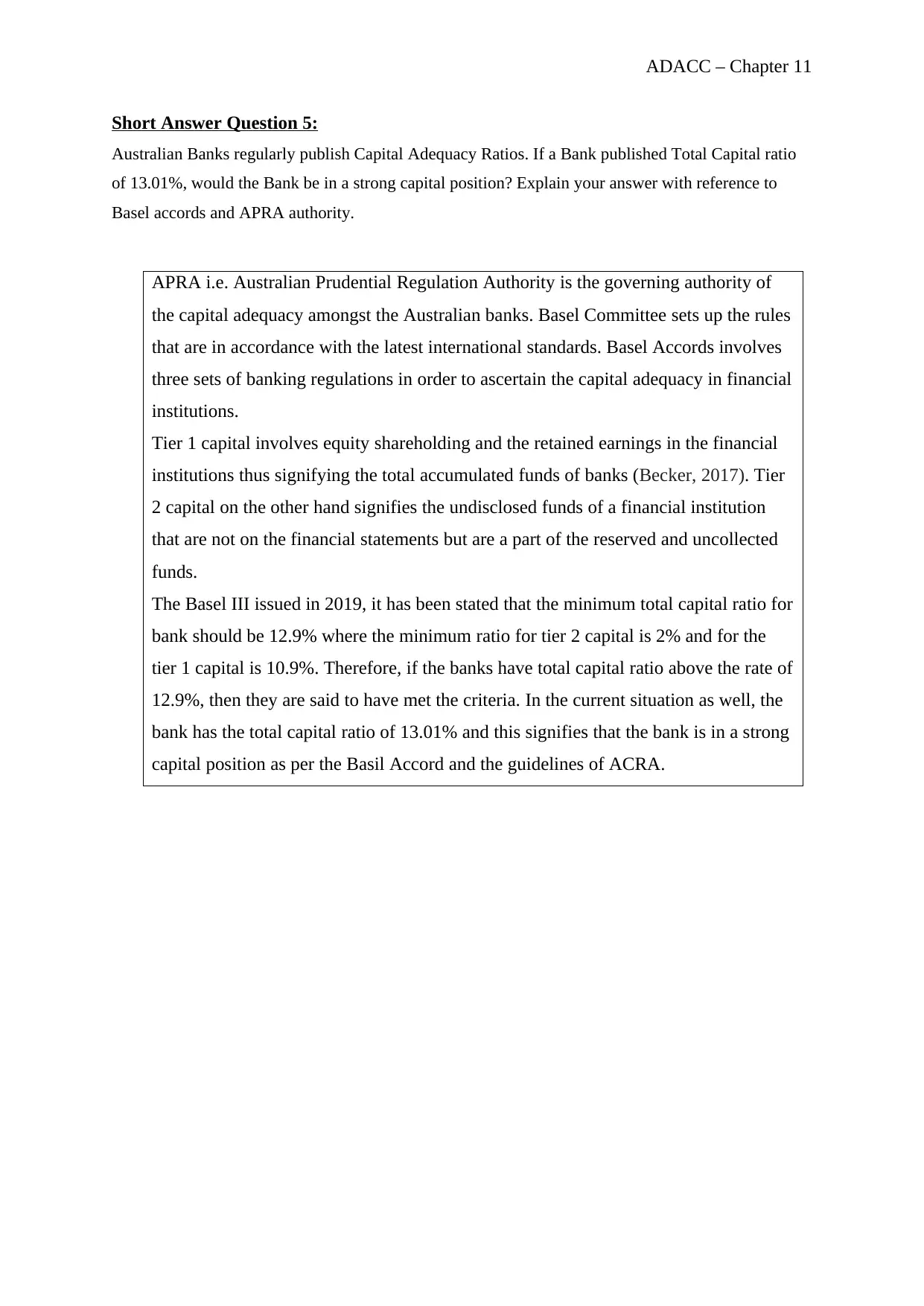
ADACC – Chapter 11
Short Answer Question 5:
Australian Banks regularly publish Capital Adequacy Ratios. If a Bank published Total Capital ratio
of 13.01%, would the Bank be in a strong capital position? Explain your answer with reference to
Basel accords and APRA authority.
APRA i.e. Australian Prudential Regulation Authority is the governing authority of
the capital adequacy amongst the Australian banks. Basel Committee sets up the rules
that are in accordance with the latest international standards. Basel Accords involves
three sets of banking regulations in order to ascertain the capital adequacy in financial
institutions.
Tier 1 capital involves equity shareholding and the retained earnings in the financial
institutions thus signifying the total accumulated funds of banks (Becker, 2017). Tier
2 capital on the other hand signifies the undisclosed funds of a financial institution
that are not on the financial statements but are a part of the reserved and uncollected
funds.
The Basel III issued in 2019, it has been stated that the minimum total capital ratio for
bank should be 12.9% where the minimum ratio for tier 2 capital is 2% and for the
tier 1 capital is 10.9%. Therefore, if the banks have total capital ratio above the rate of
12.9%, then they are said to have met the criteria. In the current situation as well, the
bank has the total capital ratio of 13.01% and this signifies that the bank is in a strong
capital position as per the Basil Accord and the guidelines of ACRA.
Short Answer Question 5:
Australian Banks regularly publish Capital Adequacy Ratios. If a Bank published Total Capital ratio
of 13.01%, would the Bank be in a strong capital position? Explain your answer with reference to
Basel accords and APRA authority.
APRA i.e. Australian Prudential Regulation Authority is the governing authority of
the capital adequacy amongst the Australian banks. Basel Committee sets up the rules
that are in accordance with the latest international standards. Basel Accords involves
three sets of banking regulations in order to ascertain the capital adequacy in financial
institutions.
Tier 1 capital involves equity shareholding and the retained earnings in the financial
institutions thus signifying the total accumulated funds of banks (Becker, 2017). Tier
2 capital on the other hand signifies the undisclosed funds of a financial institution
that are not on the financial statements but are a part of the reserved and uncollected
funds.
The Basel III issued in 2019, it has been stated that the minimum total capital ratio for
bank should be 12.9% where the minimum ratio for tier 2 capital is 2% and for the
tier 1 capital is 10.9%. Therefore, if the banks have total capital ratio above the rate of
12.9%, then they are said to have met the criteria. In the current situation as well, the
bank has the total capital ratio of 13.01% and this signifies that the bank is in a strong
capital position as per the Basil Accord and the guidelines of ACRA.
⊘ This is a preview!⊘
Do you want full access?
Subscribe today to unlock all pages.

Trusted by 1+ million students worldwide
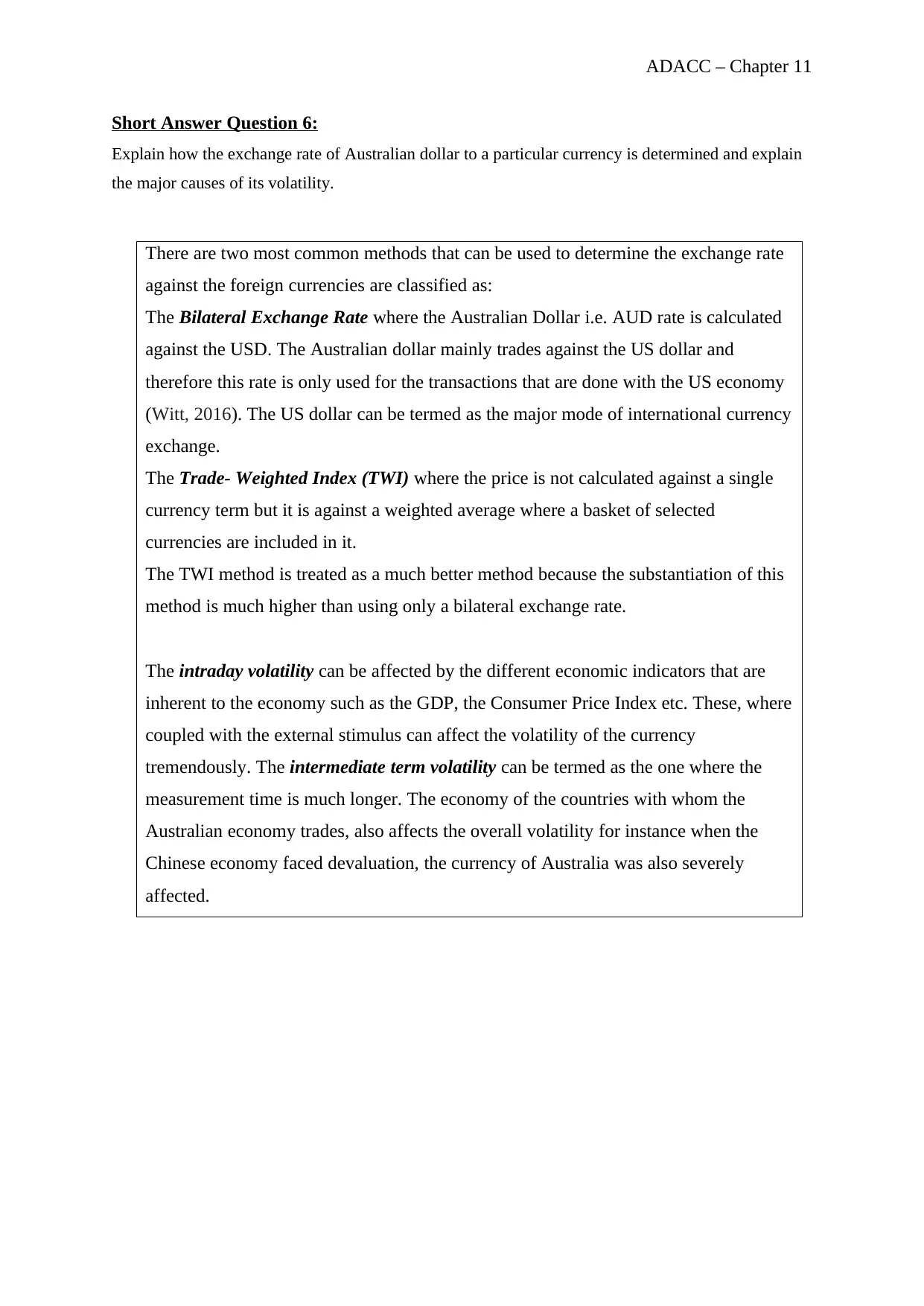
ADACC – Chapter 11
Short Answer Question 6:
Explain how the exchange rate of Australian dollar to a particular currency is determined and explain
the major causes of its volatility.
There are two most common methods that can be used to determine the exchange rate
against the foreign currencies are classified as:
The Bilateral Exchange Rate where the Australian Dollar i.e. AUD rate is calculated
against the USD. The Australian dollar mainly trades against the US dollar and
therefore this rate is only used for the transactions that are done with the US economy
(Witt, 2016). The US dollar can be termed as the major mode of international currency
exchange.
The Trade- Weighted Index (TWI) where the price is not calculated against a single
currency term but it is against a weighted average where a basket of selected
currencies are included in it.
The TWI method is treated as a much better method because the substantiation of this
method is much higher than using only a bilateral exchange rate.
The intraday volatility can be affected by the different economic indicators that are
inherent to the economy such as the GDP, the Consumer Price Index etc. These, where
coupled with the external stimulus can affect the volatility of the currency
tremendously. The intermediate term volatility can be termed as the one where the
measurement time is much longer. The economy of the countries with whom the
Australian economy trades, also affects the overall volatility for instance when the
Chinese economy faced devaluation, the currency of Australia was also severely
affected.
Short Answer Question 6:
Explain how the exchange rate of Australian dollar to a particular currency is determined and explain
the major causes of its volatility.
There are two most common methods that can be used to determine the exchange rate
against the foreign currencies are classified as:
The Bilateral Exchange Rate where the Australian Dollar i.e. AUD rate is calculated
against the USD. The Australian dollar mainly trades against the US dollar and
therefore this rate is only used for the transactions that are done with the US economy
(Witt, 2016). The US dollar can be termed as the major mode of international currency
exchange.
The Trade- Weighted Index (TWI) where the price is not calculated against a single
currency term but it is against a weighted average where a basket of selected
currencies are included in it.
The TWI method is treated as a much better method because the substantiation of this
method is much higher than using only a bilateral exchange rate.
The intraday volatility can be affected by the different economic indicators that are
inherent to the economy such as the GDP, the Consumer Price Index etc. These, where
coupled with the external stimulus can affect the volatility of the currency
tremendously. The intermediate term volatility can be termed as the one where the
measurement time is much longer. The economy of the countries with whom the
Australian economy trades, also affects the overall volatility for instance when the
Chinese economy faced devaluation, the currency of Australia was also severely
affected.
Paraphrase This Document
Need a fresh take? Get an instant paraphrase of this document with our AI Paraphraser
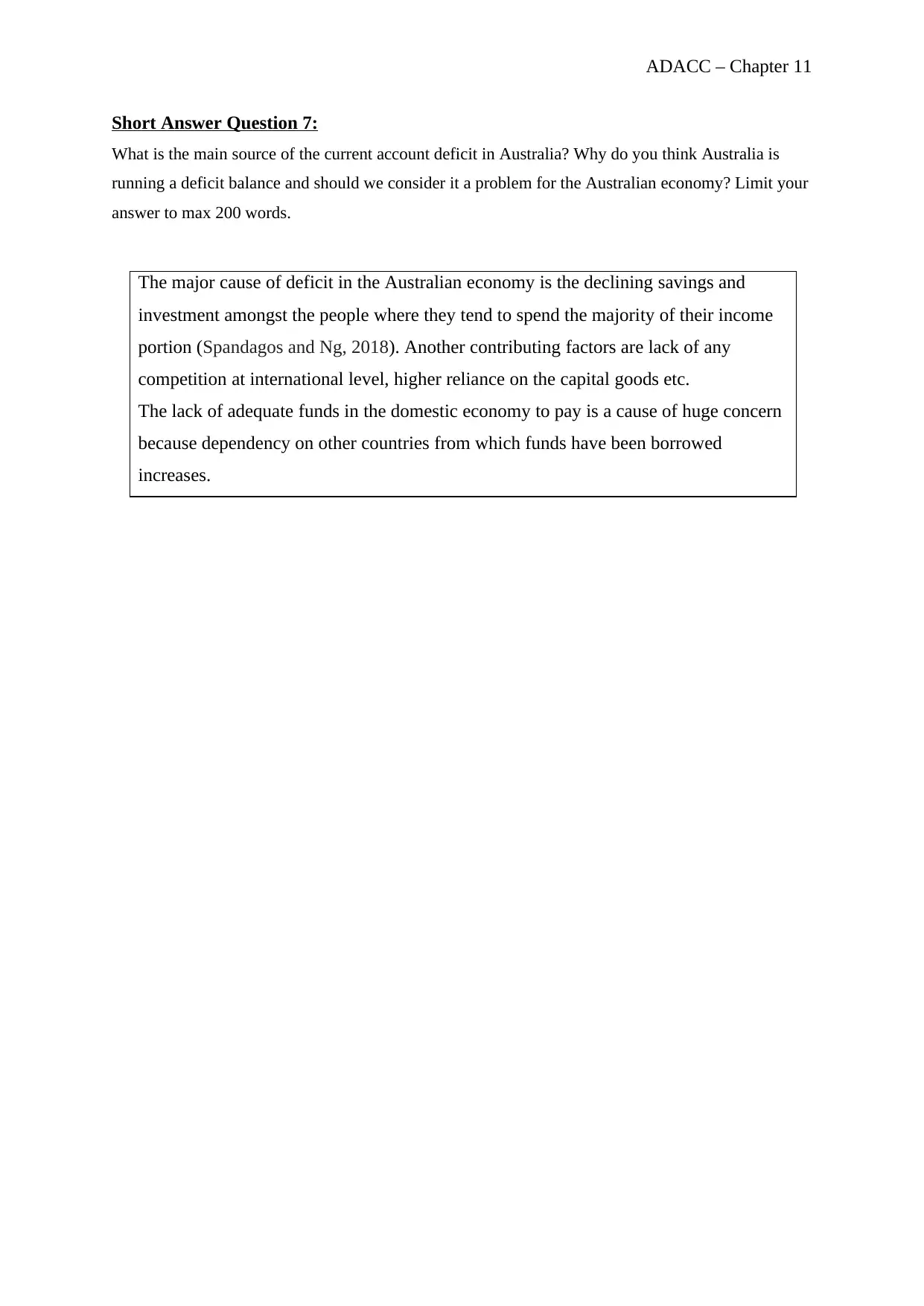
ADACC – Chapter 11
Short Answer Question 7:
What is the main source of the current account deficit in Australia? Why do you think Australia is
running a deficit balance and should we consider it a problem for the Australian economy? Limit your
answer to max 200 words.
The major cause of deficit in the Australian economy is the declining savings and
investment amongst the people where they tend to spend the majority of their income
portion (Spandagos and Ng, 2018). Another contributing factors are lack of any
competition at international level, higher reliance on the capital goods etc.
The lack of adequate funds in the domestic economy to pay is a cause of huge concern
because dependency on other countries from which funds have been borrowed
increases.
Short Answer Question 7:
What is the main source of the current account deficit in Australia? Why do you think Australia is
running a deficit balance and should we consider it a problem for the Australian economy? Limit your
answer to max 200 words.
The major cause of deficit in the Australian economy is the declining savings and
investment amongst the people where they tend to spend the majority of their income
portion (Spandagos and Ng, 2018). Another contributing factors are lack of any
competition at international level, higher reliance on the capital goods etc.
The lack of adequate funds in the domestic economy to pay is a cause of huge concern
because dependency on other countries from which funds have been borrowed
increases.
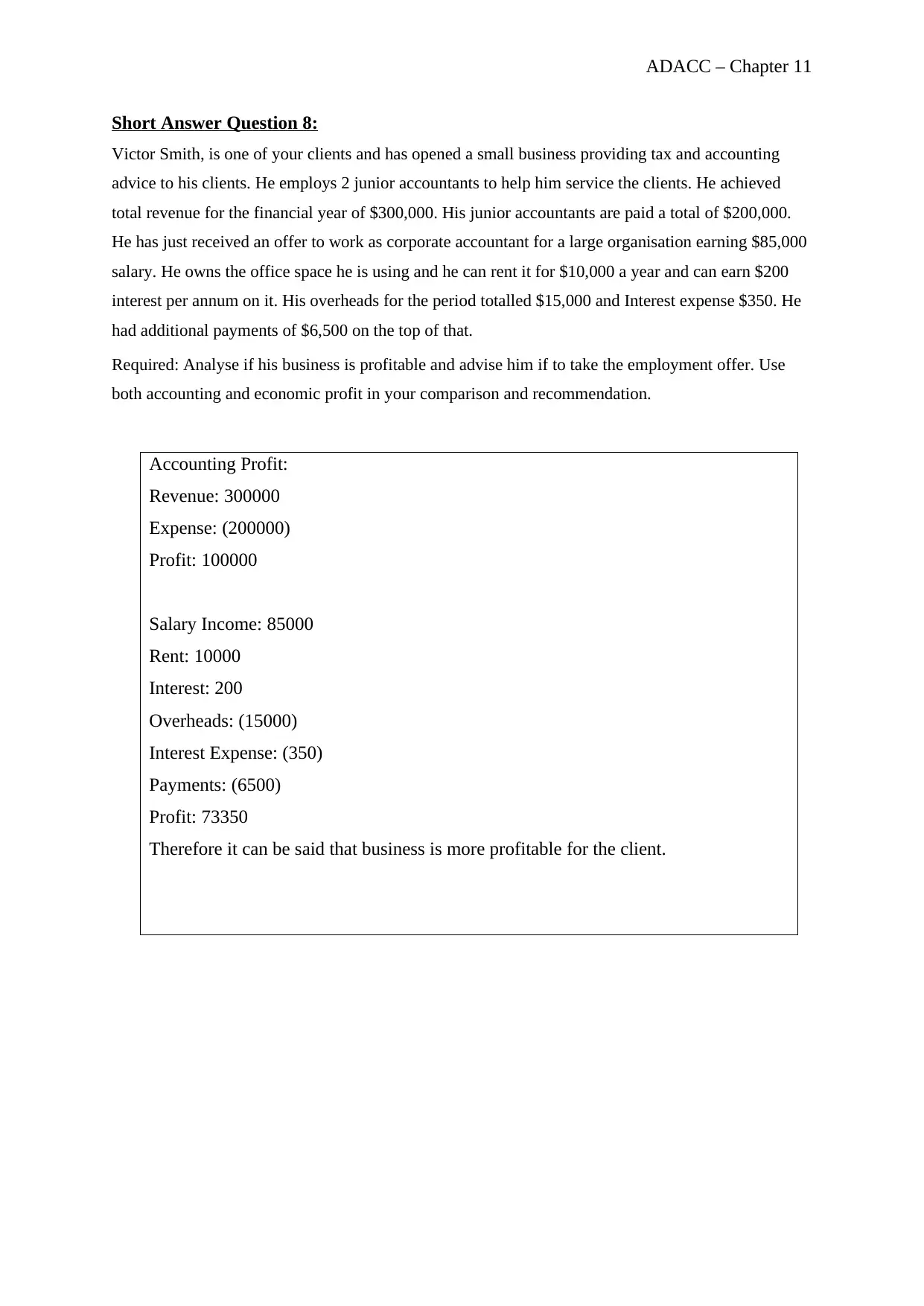
ADACC – Chapter 11
Short Answer Question 8:
Victor Smith, is one of your clients and has opened a small business providing tax and accounting
advice to his clients. He employs 2 junior accountants to help him service the clients. He achieved
total revenue for the financial year of $300,000. His junior accountants are paid a total of $200,000.
He has just received an offer to work as corporate accountant for a large organisation earning $85,000
salary. He owns the office space he is using and he can rent it for $10,000 a year and can earn $200
interest per annum on it. His overheads for the period totalled $15,000 and Interest expense $350. He
had additional payments of $6,500 on the top of that.
Required: Analyse if his business is profitable and advise him if to take the employment offer. Use
both accounting and economic profit in your comparison and recommendation.
Accounting Profit:
Revenue: 300000
Expense: (200000)
Profit: 100000
Salary Income: 85000
Rent: 10000
Interest: 200
Overheads: (15000)
Interest Expense: (350)
Payments: (6500)
Profit: 73350
Therefore it can be said that business is more profitable for the client.
Short Answer Question 8:
Victor Smith, is one of your clients and has opened a small business providing tax and accounting
advice to his clients. He employs 2 junior accountants to help him service the clients. He achieved
total revenue for the financial year of $300,000. His junior accountants are paid a total of $200,000.
He has just received an offer to work as corporate accountant for a large organisation earning $85,000
salary. He owns the office space he is using and he can rent it for $10,000 a year and can earn $200
interest per annum on it. His overheads for the period totalled $15,000 and Interest expense $350. He
had additional payments of $6,500 on the top of that.
Required: Analyse if his business is profitable and advise him if to take the employment offer. Use
both accounting and economic profit in your comparison and recommendation.
Accounting Profit:
Revenue: 300000
Expense: (200000)
Profit: 100000
Salary Income: 85000
Rent: 10000
Interest: 200
Overheads: (15000)
Interest Expense: (350)
Payments: (6500)
Profit: 73350
Therefore it can be said that business is more profitable for the client.
⊘ This is a preview!⊘
Do you want full access?
Subscribe today to unlock all pages.

Trusted by 1+ million students worldwide
1 out of 26
Related Documents
Your All-in-One AI-Powered Toolkit for Academic Success.
+13062052269
info@desklib.com
Available 24*7 on WhatsApp / Email
![[object Object]](/_next/static/media/star-bottom.7253800d.svg)
Unlock your academic potential
Copyright © 2020–2025 A2Z Services. All Rights Reserved. Developed and managed by ZUCOL.





